Sparse Sensing and Machine Learning for Rapid Calibration of Defect Detection with rf Atomic Magnetometers
Abstract
1. Introduction
1.1. Challenge and Motivation
1.1.1. Bias Field Calibration for Self-Compensation Measurement Geometry
1.1.2. Measurement Acquisition Time
1.1.3. Statistical Methods and Machine Learning
1.2. Aim and Scope
1.3. Paper Structure
2. Methods
2.1. Optimising Sensing Locations and Full-Resolution Measurement Reconstruction
2.2. Image Processing for Self-Compensation Calibration
2.2.1. Qualification: Calibrated Image Detection
2.2.2. Feedback: Direction Adjustment Vector
3. Experimental Setup
4. Results
4.1. Conventional Method for Calibration
4.2. Sensing Pixel Location Optimisation
4.2.1. Training Dataset
4.2.2. Validation Dataset
4.2.3. Reconstruction Accuracy
4.2.4. Optimal Sensor Distribution and Its Meaning
4.2.5. Image Reconstruction
4.3. Implementation of the New Calibration Method
4.3.1. Qualification: Training Dataset
4.3.2. Qualification: Image Classifications
4.3.3. Feedback: Constructing the Direction Adjustment Vector
4.3.4. Calibration Process Flowchart
4.3.5. Discussion
5. Conclusions
Supplementary Materials
Author Contributions
Funding
Data Availability Statement
Acknowledgments
Conflicts of Interest
Appendix A. Error Metrics
Appendix A.1. Mean Relative Error
Appendix A.2. Structural Similarity Index Measure
Appendix A.3. Root Mean Square Error
Appendix B. Reconstructed Images Superimposed with the Sensing Locations
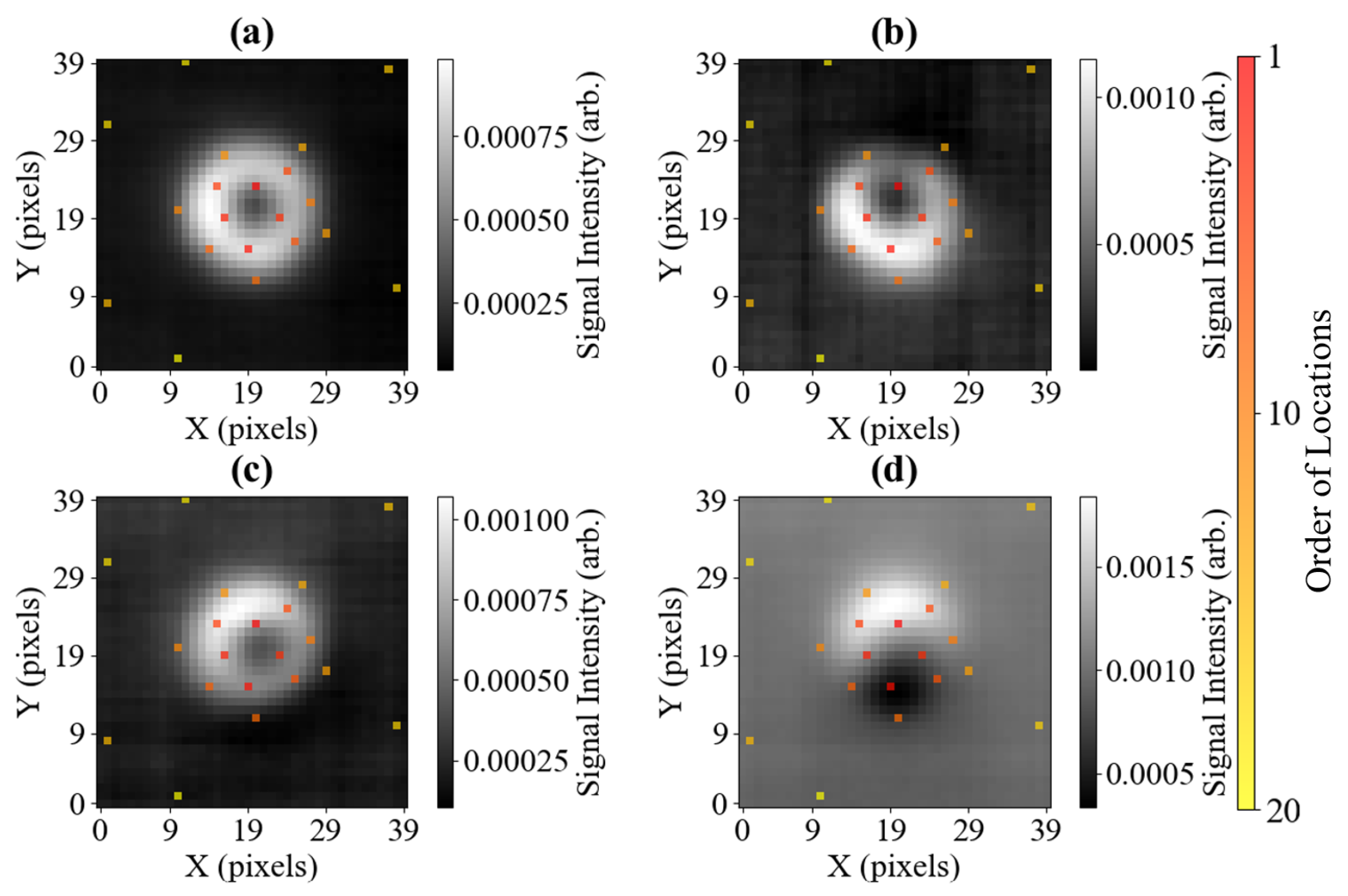
Appendix C. Convolutional Neural Network
| Layer (Type) | Number | Kernel Size | Activation |
|---|---|---|---|
| Conv2D | 32 | (3, 3) | ReLu |
| MaxPooling2D | - | (2, 2) | - |
| Conv2D | 64 | (3, 3) | ReLu |
| MaxPooling2D | - | (2, 2) | - |
| Conv2D | 64 | (3, 3) | ReLu |
| Flatten | - | - | - |
| Dense (fully-connected) | 64 | - | ReLu |
| Dense (fully-connected) | 1 | - | Sigmoid |
Appendix D. Full Calibration

| Step | Applied Field (V) | Angle (°) |
|---|---|---|
| 0 | (0.11, −0.03) | (2.2, −3.2) |
| 1 | (0.09, −0.01) | (1.5, −2.2) |
| 2 | (0.09, 0.01) | (1.5, −1.5) |
| 3 | (0.09, 0.03) | (1.5, −0.7) |
| 4 | (0.09, 0.05) | (1.5, 0.0) |
| 5 | (0.07, 0.07) | (0.7, 0.7) |
| 6 | (0.05, 0.09) | (0.0, 1.5) |
| 7 | (0.03, 0.11) | (−0.7, 2.2) |
| 8 | (0.03, 0.13) | (−0.7, 3.0) |
| 9 | (0.03, 0.15) | (−0.7, 3.7) |
References
- Murali, S. Global Non-destructive Testing (NDT) Equipment Growth Opportunities—Forecast to 2028; Frost & Sullivan: San Antonio, TX, USA, 2022. [Google Scholar]
- Griffiths, H. Magnetic induction tomography. Meas. Sci. Technol. 2001, 12, 1126–1131. [Google Scholar] [CrossRef]
- U.S. Air Force. Eddy Current Inspection Method: Technical Manual TO 33B-1-1. NDTSupply.com. Available online: https://content.ndtsupply.com/media/Eddy%20Current%20-USAF-Tech-Manual-N-R.pdf (accessed on 17 October 2025).
- Radiodetection. Theory of Buried Cable and Pipe Location; Version 10; Radiodetection Ltd.: Bristol, UK; Available online: https://www.radiodetection.com/sites/default/files/Theory-Buried-pipe-manual-V10.pdf (accessed on 17 October 2025).
- Bailey, J.; Long, N.; Hunze, A. Eddy Current Testing with Giant Magnetoresistance (GMR) Sensors and a Pipe-Encircling Excitation for Evaluation of Corrosion under Insulation. Sensors 2017, 17, 2229. [Google Scholar] [CrossRef]
- Maddox, B.; Cohen, Y.; Renzoni, F. Imaging corrosion under insulation with a mechanically-translatable atomic magnetometer. In Proceedings of the 2022 IEEE International Workshop on Metrology for Industry 4.0 & IoT (MetroInd4.0&IoT), Trento, Italy, 7–9 June 2022; pp. 104–108. [Google Scholar]
- Bevington, P.; Gartman, R.; Chalupczak, W.; Deans, C.; Marmugi, L.; Renzoni, F. Non-destructive structural imaging of steelwork with atomic magnetometers. Appl. Phys. Lett. 2018, 113, 063503. [Google Scholar] [CrossRef]
- Nugraha, K.; Hamdi, M.; Xu, Y.; Zahari, T.Z.T. Simulation of Weld Defect Detection in Steel Pipes Using Magnetic Induction Tomography Sensor Modeling. In Proceedings of the International Conference on Smart and Advanced Manufacturing (ICSAM 2024), Singapore, 2024; Hamdi, M., Xu, Y., Zahari, T.Z.T., Eds.; Lecture Notes in Mechanical Engineering; Springer: Singapore, 2024. [Google Scholar]
- Bevington, P.; Gartman, R.; Chalupczak, W. Inductive imaging of the concealed defects with radio-frequency atomic magnetometers. Appl. Sci. 2020, 10, 6871. [Google Scholar] [CrossRef]
- Ma, L.; Soleimani, M. Magnetic induction tomography methods and applications: A review. Meas. Sci. Technol. 2017, 28, 072001–072012. [Google Scholar] [CrossRef]
- Conlin, K. Tips for Reducing Error When Using Eddy Current Measuring Techniques. Kaman Precision Products, 30 April 2019. Available online: https://kaman.com/tips-for-reducing-error-when-using-eddy-current-measuring-techniques/ (accessed on 17 October 2025).
- Bevington, P.; Gartman, R.; Chalupczak, W. Imaging of material defects with a radio-frequency atomic magnetometer. Rev. Sci. Instrum. 2019, 90, 013103. [Google Scholar] [CrossRef]
- Bevington, P.; Gartman, R.; Chalupczak, W. Enhanced material defect imaging with a radio-frequency atomic magnetometer. J. Appl. Phys. 2019, 125, 094503. [Google Scholar] [CrossRef]
- Rushton, L.M.; Pyragius, T.; Meraki, A.; Elson, L.; Jensen, K. Unshielded portable optically pumped magnetometer for the remote detection of conductive objects using eddy current measurements. Rev. Sci. Instrum. 2022, 93, 125103. [Google Scholar] [CrossRef]
- Shi, Y.; Ruster, T.; Ho, M.; Karlen, S.; Haesler, J.; Treutlein, P. Broad Instantaneous Bandwidth Microwave Spectrum Analyzer with a Microfabricated Atomic Vapor Cell. Phys. Rev. X 2024, 14, 041043. [Google Scholar] [CrossRef]
- Kim, K.; Begus, S.; Xia, H.; Lee, S.K.; Jazbinsek, V.; Trontelj, Z.; Romalis, M.V. Multi-channel atomic magnetometer for magnetoencephalography: A configuration study. Neuroimage 2014, 89, 143–151. [Google Scholar] [CrossRef]
- Kim, Y.J.; Savukov, I. Highly sensitive multi-channel atomic magnetometer. In Proceedings of the IEEE Sensors Applications Symposium, Seoul, Republic of Korea, 12–14 March 2018; pp. 1–4. [Google Scholar]
- Xia, Y.; Han, S.W.; Kwon, H.J. Image Generation and Recognition for Railway Surface Defect Detection. Sensors 2023, 23, 4793. [Google Scholar] [CrossRef] [PubMed]
- Pedrayes, O.D.; Lema, D.G.; Usamentiaga, R.; Venegas, P.; García, D.F. Semantic Segmentation for Non-Destructive Testing with Step-Heating Thermography for Composite Laminates. Measurement 2022, 200, 111653. [Google Scholar] [CrossRef]
- Deans, C.; Griffin, L.D.; Marmugi, L.; Renzoni, F. Machine Learning Based Localization and Classification with Atomic Magnetometers. Phys. Rev. Lett. 2018, 120, 033204. [Google Scholar] [CrossRef] [PubMed]
- Han, M.; Cheng, X.; Xue, Y. Comparison with Reconstruction Algorithms in Magnetic Induction Tomography. Physiol. Meas. 2016, 37, 683–697. [Google Scholar] [CrossRef]
- Manohar, K.; Hogan, T.; Buttrick, J.; Banerjee, A.G.; Kutz, J.N.; Brunton, S.L. Predicting Shim Gaps in Aircraft Assembly with Machine Learning and Sparse Sensing. J. Manuf. Syst. 2018, 48, 87–95. [Google Scholar] [CrossRef]
- Karnik, N.; Abdo, M.G.; Estrada-Perez, C.E.; Yoo, J.S.; Cogliati, J.J.; Skifton, R.S. Constrained Optimization of Sensor Placement for Nuclear Digital Twins. IEEE Sens. J. 2024, 24, 15501–15516. [Google Scholar] [CrossRef]
- Karnik, N.; Wang, C.; Bhowmik, P.K.; Cogliati, J.J.; Balderrama Prieto, S.A.; Xing, C.; Klishin, A.A.; Skifton, R.; Moussaoui, M.; Folsom, C.P.; et al. Leveraging Optimal Sparse Sensor Placement to Aggregate a Network of Digital Twins for Nuclear Subsystems. Energies 2024, 17, 3355. [Google Scholar] [CrossRef]
- Cao, J.; Bu, F.; Wang, J.; Bao, C.; Chen, W.; Dai, K. Reconstruction of Full-Field Dynamic Responses for Large-Scale Structures Using Optimal Sensor Placement. J. Sound Vib. 2023, 554, 117693. [Google Scholar] [CrossRef]
- Manohar, K.; Brunton, B.W.; Kutz, J.N.; Brunton, S.L. Data-Driven Sparse Sensor Placement for Reconstruction: Demonstrating the Benefits of Exploiting Known Patterns. IEEE Control Syst. Mag. 2018, 38, 63–86. [Google Scholar]
- Wall, M.E.; Rechtsteiner, A.; Rocha, L.M. Singular Value Decomposition and Principal Component Analysis. In A Practical Approach to Microarray Data Analysis; Berrar, D.P., Dubitzky, W., Granzow, M., Eds.; Springer: Boston, MA, USA, 2003. [Google Scholar]
- Archana, R.; Jeevaraj, P.S.E. Deep Learning Models for Digital Image Processing: A Review. Artif. Intell. Rev. 2024, 57, 11. [Google Scholar] [CrossRef]
- Chen, L.; Li, S.; Bai, Q.; Yang, J.; Jiang, S.; Miao, Y. Review of Image Classification Algorithms Based on Convolutional Neural Networks. Remote Sens. 2021, 13, 4712. [Google Scholar] [CrossRef]
- Sharma, A.; Bhardwaj, H.; Bhardwaj, A.; Sakalle, A.; Acharya, D.; Ibrahim, W.; Javed, A.R. A Machine Learning and Deep Learning Approach for Recognizing Handwritten Digits. Comput. Intell. Neurosci. 2022, 9869948. [Google Scholar] [CrossRef]
- Koman, W.; Małecki, K. Comparison of kNN Classifier and Simple Neural Network in Handwritten Digit Recognition Using MNIST Database. Commun. Comput. Inf. Sci. 2024, 1979, 264–273. [Google Scholar]
- Zhao, X.; Wang, L.; Zhang, Y.; Han, X.; Deveci, M.; Parmar, M. A Review of Convolutional Neural Networks in Computer Vision. Artif. Intell. Rev. 2024, 57, 99. [Google Scholar] [CrossRef]
- Sumit, S.S.; Anavatti, S.; Tahtali, M.; Mirjalili, S.; Turhan, U. ResNet-Lite: On Improving Image Classification with a Lightweight Network. Procedia Comput. Sci. 2024, 246, 1488–1497. [Google Scholar] [CrossRef]
- Savukov, I.M.; Seltzer, S.J.; Romalis, M.V.; Sauer, K.L. Tunable atomic magnetometer for detection of radio-frequency magnetic fields. Phys. Rev. Lett. 2005, 95, 063004. [Google Scholar] [CrossRef]
- Rushton, L.M.; Ellis, L.M.; Zipfel, J.D.; Bevington, P.; Chalupczak, W. Polarization of radio-frequency magnetic fields in magnetic induction measurements with an atomic magnetometer. Phys. Rev. Appl. 2024, 22, 014002. [Google Scholar] [CrossRef]
- Bevington, P.; Gartman, R.; Botelho, D.J.; Crawford, R.; Packer, M.; Fromhold, T.M.; Chalupczak, W. Object surveillance with radio-frequency atomic magnetometers. Rev. Sci. Instrum. 2020, 91, 055002. [Google Scholar] [CrossRef]
- Anderson, E.; Bai, Z.; Bischof, C.; Blackford, L.S.; Demmel, J.; Dongarra, J.; Du Croz, J.; Greenbaum, A.; Hammarling, S.; McKenney, A.; et al. LAPACK Users’ Guide; Society for Industrial and Applied Mathematics: Philadelphia, PA, USA, 1999; ISBN 978-0-89871-447-0. [Google Scholar]
- Sid-Lakhdar, W.; Cayrols, S.; Bielich, D.; Abdelfattah, A.; Luszczek, P.; Gates, M. PAQR: Pivoting Avoiding QR factorization. In Proceedings of the 2023 IEEE International Parallel and Distributed Processing Symposium (IPDPS), St. Petersburg, FL, USA, 15–19 May 2023. [Google Scholar]
- Wang, Z.; Simoncelli, E.P.; Bovik, A.C. Multiscale structural similarity for image quality assessment. In Proceedings of the The Thrity-Seventh Asilomar Conference on Signals, Systems & Computers, 2003, Pacific Grove, CA, USA, 9–12 November 2003. [Google Scholar]

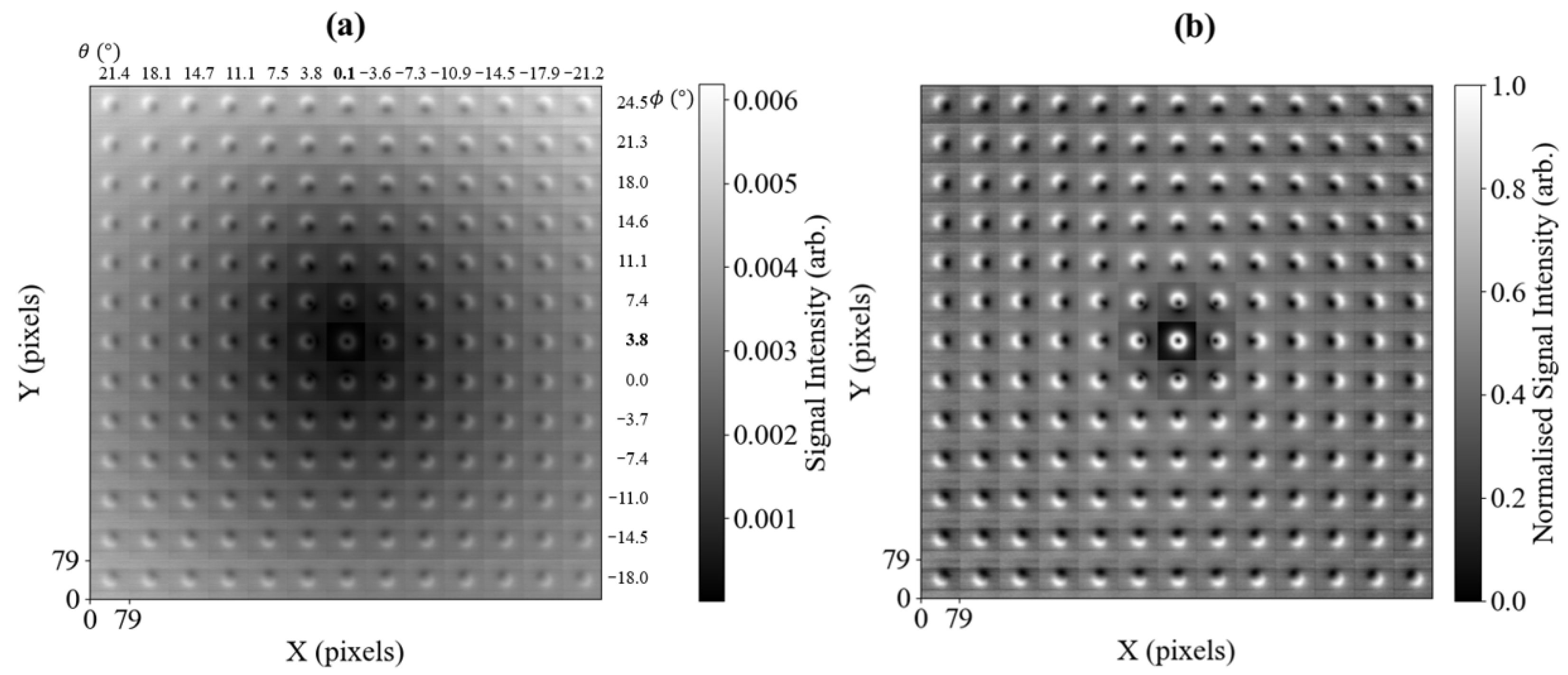


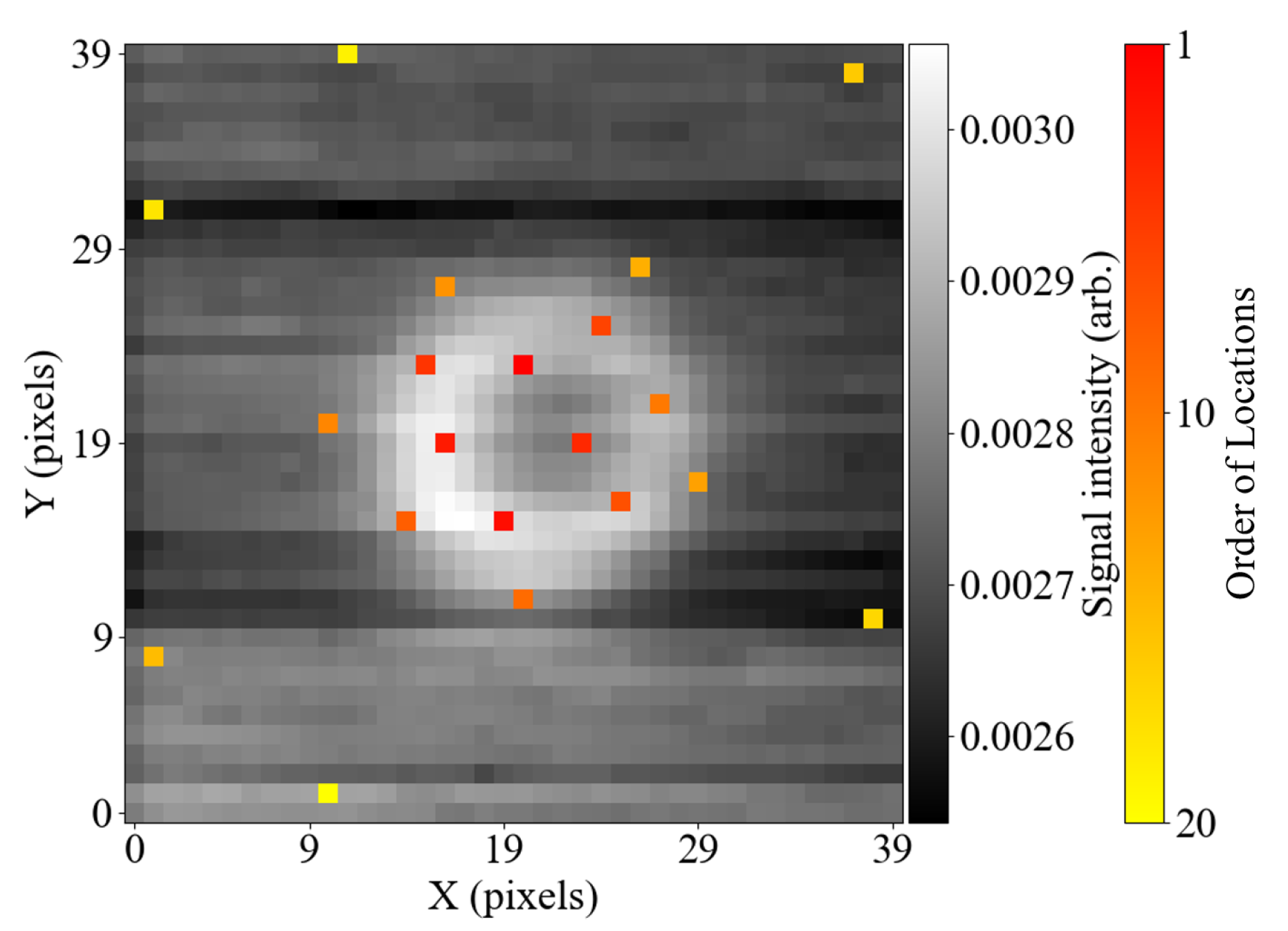
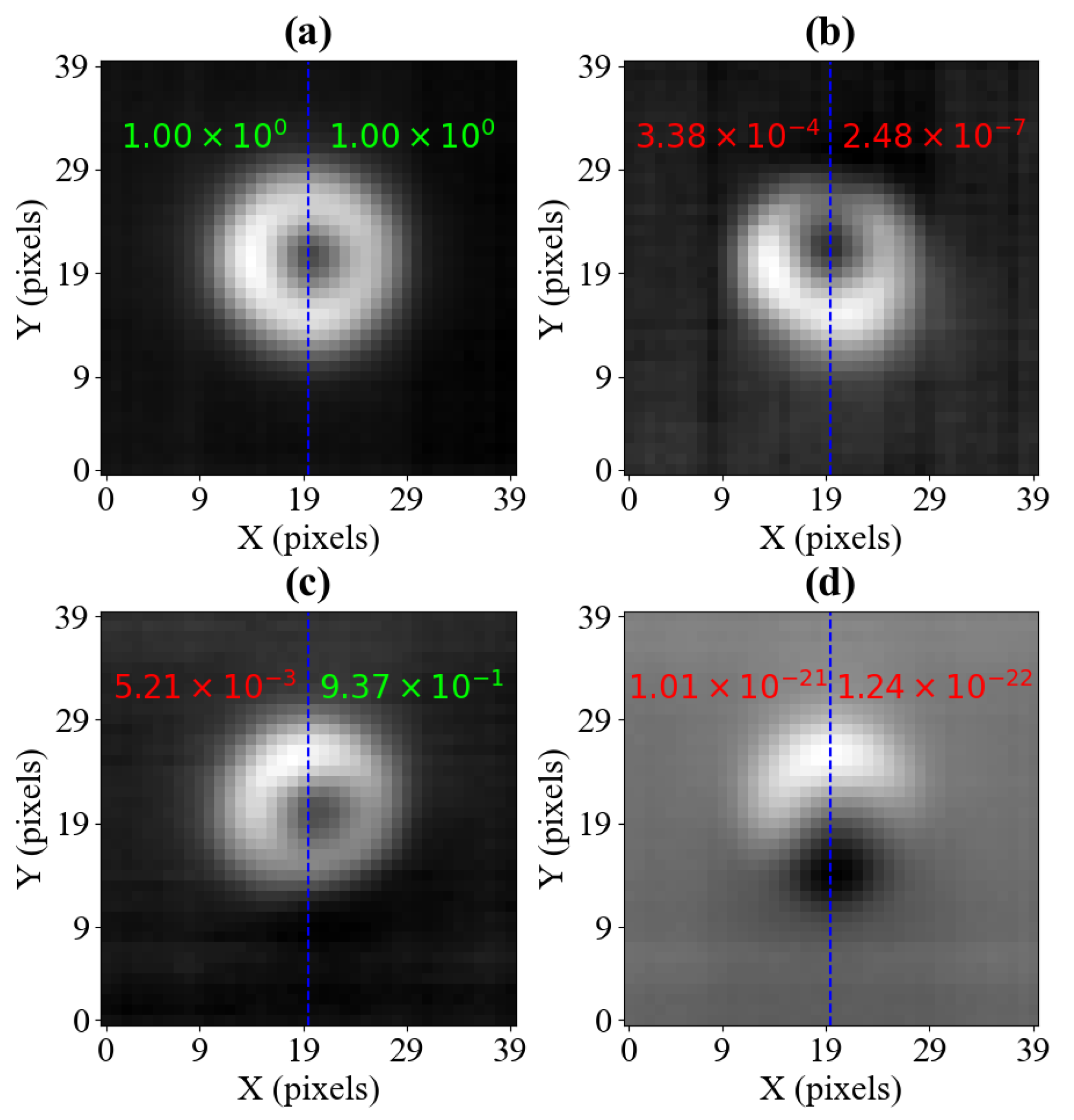

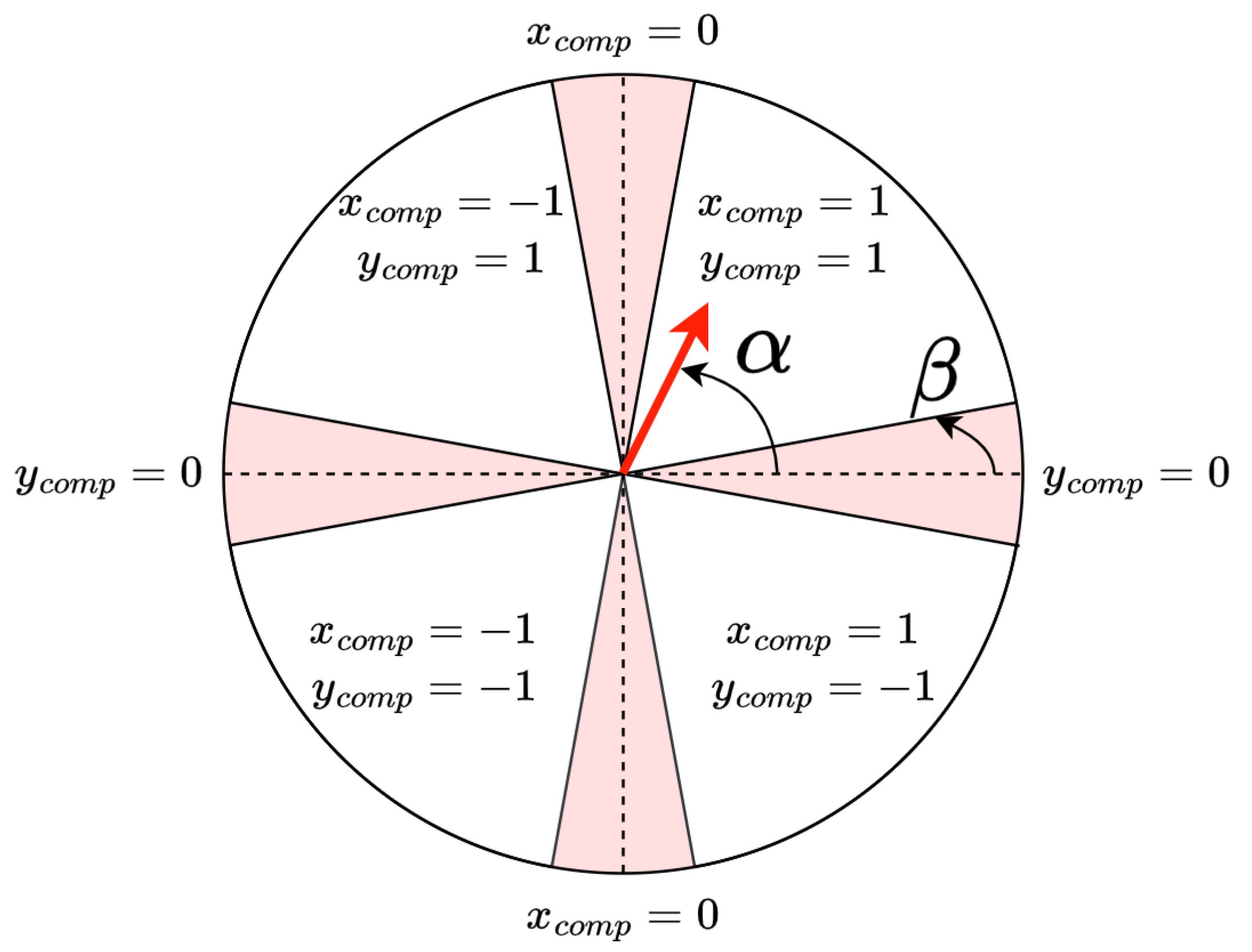

| PID Setpoint | Bias Magnetic Field Component | Angle with z-Axis |
|---|---|---|
| - |
Disclaimer/Publisher’s Note: The statements, opinions and data contained in all publications are solely those of the individual author(s) and contributor(s) and not of MDPI and/or the editor(s). MDPI and/or the editor(s) disclaim responsibility for any injury to people or property resulting from any ideas, methods, instructions or products referred to in the content. |
© 2025 by the authors. Licensee MDPI, Basel, Switzerland. This article is an open access article distributed under the terms and conditions of the Creative Commons Attribution (CC BY) license (https://creativecommons.org/licenses/by/4.0/).
Share and Cite
Munko, M.J.; Rushton, L.M.; Ellis, L.M.; Zipfel, J.D.; Bevington, P.; Chalupczak, W.; Lopez Dubon, S. Sparse Sensing and Machine Learning for Rapid Calibration of Defect Detection with rf Atomic Magnetometers. Sensors 2025, 25, 6930. https://doi.org/10.3390/s25226930
Munko MJ, Rushton LM, Ellis LM, Zipfel JD, Bevington P, Chalupczak W, Lopez Dubon S. Sparse Sensing and Machine Learning for Rapid Calibration of Defect Detection with rf Atomic Magnetometers. Sensors. 2025; 25(22):6930. https://doi.org/10.3390/s25226930
Chicago/Turabian StyleMunko, Marek J., Lucas M. Rushton, Laura M. Ellis, Jake D. Zipfel, Patrick Bevington, Witold Chalupczak, and Sergio Lopez Dubon. 2025. "Sparse Sensing and Machine Learning for Rapid Calibration of Defect Detection with rf Atomic Magnetometers" Sensors 25, no. 22: 6930. https://doi.org/10.3390/s25226930
APA StyleMunko, M. J., Rushton, L. M., Ellis, L. M., Zipfel, J. D., Bevington, P., Chalupczak, W., & Lopez Dubon, S. (2025). Sparse Sensing and Machine Learning for Rapid Calibration of Defect Detection with rf Atomic Magnetometers. Sensors, 25(22), 6930. https://doi.org/10.3390/s25226930






